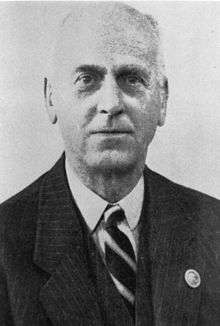Edward Masterman
Air Commodore Edward Alexander Dimsdale Masterman, CB, CMG, CBE, AFC (15 April 1880 – 26 August 1957) was a senior officer in the Royal Air Force in the first half of the 20th century. After retiring from the RAF, he served as the first ever Commandant of the Observer Corps.
Edward Masterman | |
|---|---|
 Air Commodore Edward Masterman, pictured wearing an early Observer Corps lapel badge on his suit jacket. | |
| Born | 15 April 1880 |
| Died | 26 August 1957 (aged 77) Aldershot, Hampshire |
| Allegiance | United Kingdom |
| Service/ | Royal Navy (c. 1894–1918) Royal Air Force (1918–29) |
| Years of service | 1894–1929 |
| Rank | Air Commodore |
| Commands held | No. 10 Group (1924–28) No. 7 Group (1923–24) Central Flying School (1922) No. 22 Group (1918–19) Farnborough Airship Station (1914–15) Naval Airship Section HMS Vesuvius (1909–12) |
| Battles/wars | First World War |
| Awards | Companion of the Order of the Bath Companion of the Order of St Michael and St George Commander of the Order of the British Empire Air Force Cross |
| Other work | Commandant of the Observer Corps (1929–36) |
Service career
Masterman started his service career in the Royal Navy, attending the Britannia Naval College around 1894. He served on HMS Revenge in the late 1890s and early 1900s, and was promoted to lieutenant in January 1900.[1] After attending Torpedo Specialist Course he in 1907 worked as a Russia interpreter on HMS Vernon.[2]
By 1911 Masterman had become involved in the Navy's efforts to build an experimental airship and the following year he was appointed Officer Commanding the Naval Airship Section.[2]
During the First World War, Masterman served in the Royal Naval Air Service, commanding the Farnborough Airship Station and working in several technical posts; during this time he invented and patented the airship mooring mast with Barnes Wallis. With the establishment of the Royal Air Force on 1 April 1918, Masterman transferred to the new service. Just before the end of the war, he was promoted to brigadier general and appointed General Officer Commanding No. 22 Group. His rank was commuted to air commodore when current RAF ranks were introduced. In 1922 Masterman was appointed as Commandant of the RAF's Central Flying School.[2]
Observer Corps
Between 1 March 1929 when he retired from the RAF and 1 April 1936, Masterman was the Commandant of the Observer Corps and was the first former RAF officer to hold this appointment.[3] Headquarters Royal Observer Corps was located at Hillingdon House, RAF Uxbridge, only relocating to RAF Bentley Priory after Masterman retired. He was succeeded as Commandant Observer Corps by Air Commodore Alfred Warrington-Morris.
Following his retirement as Commandant, Air Commodore Masterman immediately rejoined the Royal Observer Corps as a civilian part-time volunteer with the rank of Observer Captain and served as the ROC's Western Area Commandant between 1937 and 1942, although by special permission of Warrington-Morris, he was permitted to wear his RAF Air Commodore's uniform and rank braid after April 1941 when the Observer Corps became the Royal Observer Corps and part of RAF Fighter Command.
References
- "No. 27308". The London Gazette. 26 April 1901. p. 2858.
- "Air Commodore E A D Masterman". Air of Authority – A History of RAF Organisation. Retrieved 7 June 2015.
- "Units directly responsible to Ministry level". rafweb.org. Retrieved 7 June 2015.
External links
| Military offices | ||
|---|---|---|
| New title Group established |
General Officer Commanding No. 22 Group 1918–1919 |
Vacant Title next held by Duncan Pitcher |
| Preceded by Norman MacEwen |
Commandant of the Central Flying School 1922 |
Succeeded by Felton Holt |
| Preceded by Lionel Charlton |
Air Officer Commanding No. 7 Group 1923–1924 |
Succeeded by Arthur Longmore |
| Preceded by J L Forbes |
Air Officer Commanding No. 10 Group 1924–1928 |
Succeeded by Thomas Higgins |
| Government offices | ||
| New title Corps established |
Commandant Observer Corps 1929–1936 |
Succeeded by Alfred Warrington Morris |